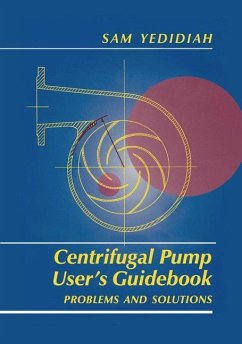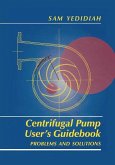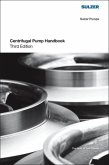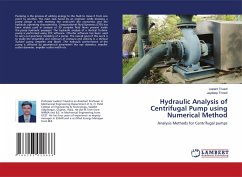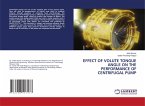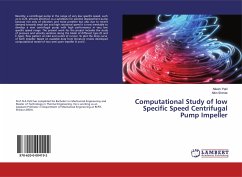Centrifugal Pump User's Guidebook
Problems and Solutions
Herausgegeben von Yedidiah, Shmariahu
Centrifugal Pump User's Guidebook
Problems and Solutions
Herausgegeben von Yedidiah, Shmariahu
- Broschiertes Buch
- Merkliste
- Auf die Merkliste
- Bewerten Bewerten
- Teilen
- Produkt teilen
- Produkterinnerung
- Produkterinnerung
Specifically for the pump user, this book concentrates on the identification and solution of problems associated with existing centrifugal pumps. It gives specific examples on how to modify pump performance for increased efficiency and better quality control, which turn into long-term cost savings. Some basic theory is included to give the reader greater understanding of the problems being encountered and attacked.
Andere Kunden interessierten sich auch für
![Centrifugal Pump User's Guidebook Centrifugal Pump User's Guidebook]() Shmariahu Yedidiah (Hrsg.)Centrifugal Pump User's Guidebook191,99 €
Shmariahu Yedidiah (Hrsg.)Centrifugal Pump User's Guidebook191,99 €![Centrifugal Pump Handbook Centrifugal Pump Handbook]() Sulzer Sulzer PumpsCentrifugal Pump Handbook125,99 €
Sulzer Sulzer PumpsCentrifugal Pump Handbook125,99 €![Hydraulic Analysis of Centrifugal Pump using Numerical Method Hydraulic Analysis of Centrifugal Pump using Numerical Method]() Jvalant TrivediHydraulic Analysis of Centrifugal Pump using Numerical Method27,99 €
Jvalant TrivediHydraulic Analysis of Centrifugal Pump using Numerical Method27,99 €![Centrifugal Pump Design Centrifugal Pump Design]() John TuzsonCentrifugal Pump Design165,99 €
John TuzsonCentrifugal Pump Design165,99 €![Optimal Parameters of a Centrifugal Pump for Heavy End Recovery Optimal Parameters of a Centrifugal Pump for Heavy End Recovery]() Sylvanus Onyenkachi IsaacOptimal Parameters of a Centrifugal Pump for Heavy End Recovery55,99 €
Sylvanus Onyenkachi IsaacOptimal Parameters of a Centrifugal Pump for Heavy End Recovery55,99 €![EFFECT OF VOLUTE TONGUE ANGLE ON THE PERFORMANCE OF CENTRIFUGAL PUMP EFFECT OF VOLUTE TONGUE ANGLE ON THE PERFORMANCE OF CENTRIFUGAL PUMP]() Ankit KumarEFFECT OF VOLUTE TONGUE ANGLE ON THE PERFORMANCE OF CENTRIFUGAL PUMP29,99 €
Ankit KumarEFFECT OF VOLUTE TONGUE ANGLE ON THE PERFORMANCE OF CENTRIFUGAL PUMP29,99 €![Computational Study of low Specific Speed Centrifugal Pump Impeller Computational Study of low Specific Speed Centrifugal Pump Impeller]() Nilesh PatilComputational Study of low Specific Speed Centrifugal Pump Impeller27,99 €
Nilesh PatilComputational Study of low Specific Speed Centrifugal Pump Impeller27,99 €-
-
-
Specifically for the pump user, this book concentrates on the identification and solution of problems associated with existing centrifugal pumps. It gives specific examples on how to modify pump performance for increased efficiency and better quality control, which turn into long-term cost savings. Some basic theory is included to give the reader greater understanding of the problems being encountered and attacked.
Produktdetails
- Produktdetails
- Verlag: Springer, Berlin
- Softcover reprint of the original 1st ed. 1996
- Seitenzahl: 404
- Erscheinungstermin: 26. September 2011
- Englisch
- Abmessung: 254mm x 178mm x 22mm
- Gewicht: 790g
- ISBN-13: 9781461285168
- ISBN-10: 146128516X
- Artikelnr.: 36115138
- Herstellerkennzeichnung
- Springer-Verlag GmbH
- Tiergartenstr. 17
- 69121 Heidelberg
- ProductSafety@springernature.com
- Verlag: Springer, Berlin
- Softcover reprint of the original 1st ed. 1996
- Seitenzahl: 404
- Erscheinungstermin: 26. September 2011
- Englisch
- Abmessung: 254mm x 178mm x 22mm
- Gewicht: 790g
- ISBN-13: 9781461285168
- ISBN-10: 146128516X
- Artikelnr.: 36115138
- Herstellerkennzeichnung
- Springer-Verlag GmbH
- Tiergartenstr. 17
- 69121 Heidelberg
- ProductSafety@springernature.com
I. Introduction.- 1. Rotodynamic Pumps.- 2. Performance Chracteristics of Centrifugal Pumps.- 3. Classification of Centrifugal Pumps.- II. Performance Factors.- 4. Effects of Free Air in the Pumped Liquid.- 5. Cavitation.- 6. Cavitation in Centrifugal Pumps.- 7. Losses of Energy.- 8. Effects of Temperature and Viscosity on Pump Performance.- 9. Recirculation.- 10. Axial and Radial Thrust and Balancing.- 11. Miscellaneous Factors that Affect Pump Performance.- III. Problems Encountered with Centrifugal Pumps.- 12. Testing.- 13. Pump Performance at Reduced NPSH.- 14. Pumping System Layout.- 15. Installation, Handling, and Operation of Pumps and Pumping Systems.- 16. Problems with Bearings.- 17. Sealing Rotating Parts.- 18. Miscellaneous Studies.- 19. Problems Related to Specific Circumstances.- 20. Special Cases that Have Proven Very Difficult to Solve.- IV. Solving Pump Problems.- 21. Solving Problems Prior to Visiting the Site.- 22. Conclusions Drawn from Visual Inspection of Failed Parts.- 23. On-Site Inspection and Testing.- V. Eliminating Pump Problems and Modifying Performance.- 24. Remedial Methods.- 25. The Effects of Speed and Impeller OD on Pump Performance.- 26. The Effects of Reducing the Impeller Width.- 27. Modifying the Casing Geometry.- 28. Various Methods of Altering Pump Performance.- VI. A Glimpse of the Future.- 29. New Findings Concerning the Mode of Operation of Rotodynamic Impellers.- 30. Some Future Applications of the Presented Theory.- 1. Pump Does Not Develop Any Head, Nor Does It Deliver Liquid.- 2. Pump Develops Some Pressure, but Delivers No Liquid.- 3. Pump Delivers Less Liquid Than Expected.- 4. Pump Does Not Develop Enough Pressure.- 5. Shape of Head-Capacity Curve Differs from Rated Curve.- 6. Pump Consumes Too Much Power.- 7. Pump Does Not Perform Satisfactorily, Although Nothing Appears to be Wrong with Pumping Unit or System.- 8. Pump Operates Satisfactorily During Start, but Performance Deteriorates in a Relatively Short Time.- 9. Pump is Operating with Noise, Vibrations, or Both.- 10. Stuffing Box Leaks Excessively.- 11. Packing Has Short Life.- 12. Mechanical Seal Has Short Life.- 13. Mechanical Seal Leaks Excessively.- 14. Bearings Have Short Life.- 15. Bearings Overheat.- 16. Bearings Operate with Noise.- 17. Pump Overheats, Seizes, or Both.- 18. Impeller or Casing, or Both, Has Short Life.- 19. Loud Blow is Heard Each Time Pump is Started or Stopped.- 20. Casing Bursts Each Time Pump is Started or Stopped.- 21. Gaskets Leak During Pump Operation.- 22. Flow-Rate Periodically Decreases, or Stops Completely, then Returns to Normal.- 23. Pump Develops Cavitation when the Available NPSH is Increased.- Vapor Pressures of Water at Different Temperatures.- Gall Resistance of Material Combinations.- Packing Selections.- Tables of Chemical Compatibility of Materials.
I. Introduction.- 1. Rotodynamic Pumps.- 2. Performance Chracteristics of Centrifugal Pumps.- 3. Classification of Centrifugal Pumps.- II. Performance Factors.- 4. Effects of Free Air in the Pumped Liquid.- 5. Cavitation.- 6. Cavitation in Centrifugal Pumps.- 7. Losses of Energy.- 8. Effects of Temperature and Viscosity on Pump Performance.- 9. Recirculation.- 10. Axial and Radial Thrust and Balancing.- 11. Miscellaneous Factors that Affect Pump Performance.- III. Problems Encountered with Centrifugal Pumps.- 12. Testing.- 13. Pump Performance at Reduced NPSH.- 14. Pumping System Layout.- 15. Installation, Handling, and Operation of Pumps and Pumping Systems.- 16. Problems with Bearings.- 17. Sealing Rotating Parts.- 18. Miscellaneous Studies.- 19. Problems Related to Specific Circumstances.- 20. Special Cases that Have Proven Very Difficult to Solve.- IV. Solving Pump Problems.- 21. Solving Problems Prior to Visiting the Site.- 22. Conclusions Drawn from Visual Inspection of Failed Parts.- 23. On-Site Inspection and Testing.- V. Eliminating Pump Problems and Modifying Performance.- 24. Remedial Methods.- 25. The Effects of Speed and Impeller OD on Pump Performance.- 26. The Effects of Reducing the Impeller Width.- 27. Modifying the Casing Geometry.- 28. Various Methods of Altering Pump Performance.- VI. A Glimpse of the Future.- 29. New Findings Concerning the Mode of Operation of Rotodynamic Impellers.- 30. Some Future Applications of the Presented Theory.- 1. Pump Does Not Develop Any Head, Nor Does It Deliver Liquid.- 2. Pump Develops Some Pressure, but Delivers No Liquid.- 3. Pump Delivers Less Liquid Than Expected.- 4. Pump Does Not Develop Enough Pressure.- 5. Shape of Head-Capacity Curve Differs from Rated Curve.- 6. Pump Consumes Too Much Power.- 7. Pump Does Not Perform Satisfactorily, Although Nothing Appears to be Wrong with Pumping Unit or System.- 8. Pump Operates Satisfactorily During Start, but Performance Deteriorates in a Relatively Short Time.- 9. Pump is Operating with Noise, Vibrations, or Both.- 10. Stuffing Box Leaks Excessively.- 11. Packing Has Short Life.- 12. Mechanical Seal Has Short Life.- 13. Mechanical Seal Leaks Excessively.- 14. Bearings Have Short Life.- 15. Bearings Overheat.- 16. Bearings Operate with Noise.- 17. Pump Overheats, Seizes, or Both.- 18. Impeller or Casing, or Both, Has Short Life.- 19. Loud Blow is Heard Each Time Pump is Started or Stopped.- 20. Casing Bursts Each Time Pump is Started or Stopped.- 21. Gaskets Leak During Pump Operation.- 22. Flow-Rate Periodically Decreases, or Stops Completely, then Returns to Normal.- 23. Pump Develops Cavitation when the Available NPSH is Increased.- Vapor Pressures of Water at Different Temperatures.- Gall Resistance of Material Combinations.- Packing Selections.- Tables of Chemical Compatibility of Materials.
`...contains information on how to attain and maintain optimum performance from centrifugal pumps and offers an approach diagnosing and solving pumps.'
Civil Engineering
Civil Engineering
`...contains information on how to attain and maintain optimum performance from centrifugal pumps and offers an approach diagnosing and solving pumps.' Civil Engineering

